engine oil capacity Seat Alhambra 2011 Owner's Manual
[x] Cancel search | Manufacturer: SEAT, Model Year: 2011, Model line: Alhambra, Model: Seat Alhambra 2011Pages: 385, PDF Size: 7.92 MB
Page 190 of 385
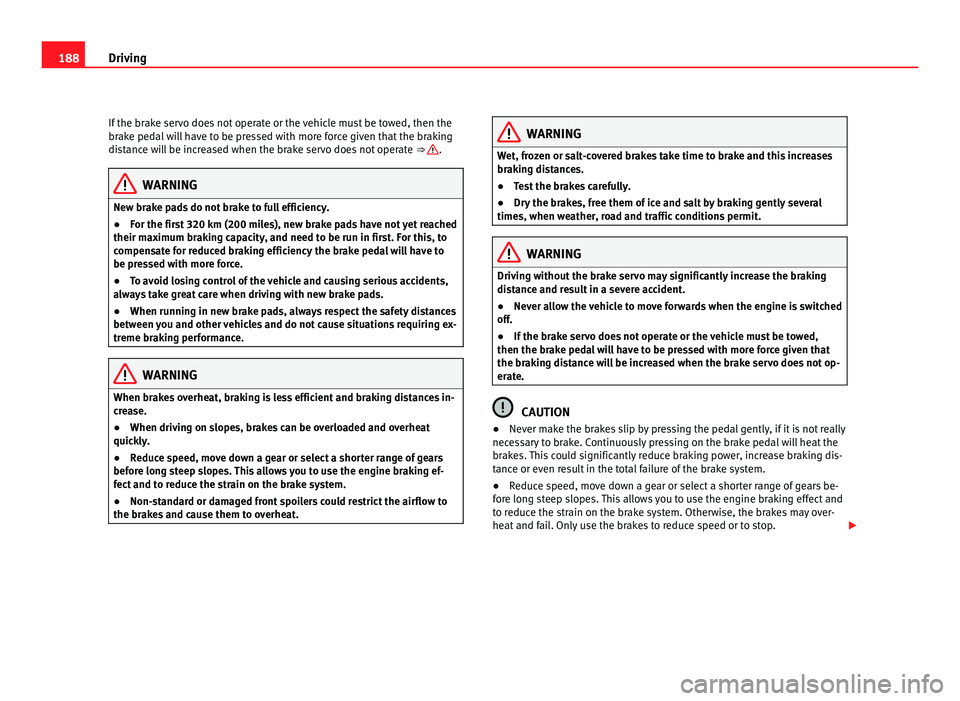
188
Driving
If the brake servo does not operate or the vehicle must be towed, then the
brak e ped
al will have to be pressed with more force given that the braking
distance will be increased when the brake servo does not operate ⇒ .
WARNING
New brake pads do not brake to full efficiency.
● For the first 320 km (200 miles), new brake pads have not yet reached
their max imum br
aking capacity, and need to be run in first. For this, to
compensate for reduced braking efficiency the brake pedal will have to
be pressed with more force.
● To avoid losing control of the vehicle and causing serious accidents,
alwa
ys take great care when driving with new brake pads.
● When running in new brake pads, always respect the safety distances
between y
ou and other vehicles and do not cause situations requiring ex-
treme braking performance. WARNING
When brakes overheat, braking is less efficient and braking distances in-
cr e
ase.
● When driving on slopes, brakes can be overloaded and overheat
quickly
.
● Reduce speed, move down a gear or select a shorter range of gears
before lon
g steep slopes. This allows you to use the engine braking ef-
fect and to reduce the strain on the brake system.
● Non-standard or damaged front spoilers could restrict the airflow to
the brake
s and cause them to overheat. WARNING
Wet, frozen or salt-covered brakes take time to brake and this increases
brak in
g distances.
● Test the brakes carefully.
● Dry the brakes, free them of ice and salt by braking gently several
times, when we
ather, road and traffic conditions permit. WARNING
Driving without the brake servo may significantly increase the braking
dist
ance and result in a severe accident.
● Never allow the vehicle to move forwards when the engine is switched
off.
● If the br
ake servo does not operate or the vehicle must be towed,
then the brake ped
al will have to be pressed with more force given that
the braking distance will be increased when the brake servo does not op-
erate. CAUTION
● Never make the brakes slip by pressing the pedal gently, if it is not really
nec e
ssary to brake. Continuously pressing on the brake pedal will heat the
brakes. This could significantly reduce braking power, increase braking dis-
tance or even result in the total failure of the brake system.
● Reduce speed, move down a gear or select a shorter range of gears be-
fore lon
g steep slopes. This allows you to use the engine braking effect and
to reduce the strain on the brake system. Otherwise, the brakes may over-
heat and fail. Only use the brakes to reduce speed or to stop.
Page 265 of 385

263
Accessories, parts replacement and modifications
The vehicle should not be lifted using lifting platforms with lift pads con-
tainin g fluid.
When r
aising a vehicle using a platform or jack, a series of precautionary
measures are required. Never raise the vehicle with a lifting platform or jack
unless you have received training in how to do so and know how to lift the
vehicle safely.
Notes on raising the vehicle with a jack ⇒ page 309. WARNING
The improper use of the lifting platform or the jack when raising the vehi-
cl e m
ay result in accidents or serious injury.
● Before raising the vehicle, please observe the manufacturer's instruc-
tions f
or the platform or jack, and the legal requirements, where applica-
ble.
● There should not be anyone inside the vehicle when it is being raised
or once it i
s in the air.
● Only use the jacking points indicated in the figures ⇒ fig. 160
and
⇒ fig. 161 when raising the vehicle. If the vehicle is not lifted at the indi-
cated points, it may fall from the platform while the engine or gearbox is
being dismounted, for example.
● The jacking points should be centrally aligned and firmly positioned
on the platf
orm support plates.
● Never start the engine when the vehicle is raised! The vehicle may fall
from the pl
atform due to the engine vibrations.
● If it is necessary to work underneath the vehicle while it is raised, you
should c
heck that the supporting stands have an adequate load capacity.
● Never climb onto the lifting platform.
● Always make sure that the weight of the vehicle does not exceed the
lifting p
latform load capacity. CAUTION
● Never raise the vehicle at the engine oil sump, the gearbox or the rear or
fr ont
axles.
● Always use an intermediat
e rubber support to prevent damage to the
vehicle underbody. Check that the arms of the lifting platform are able to
move with obstruction.
● The arms should not come into contact with the side running boards or
other parts
of the vehicle. Safety First Operating instructions Practical tips Technical Data
Page 287 of 385
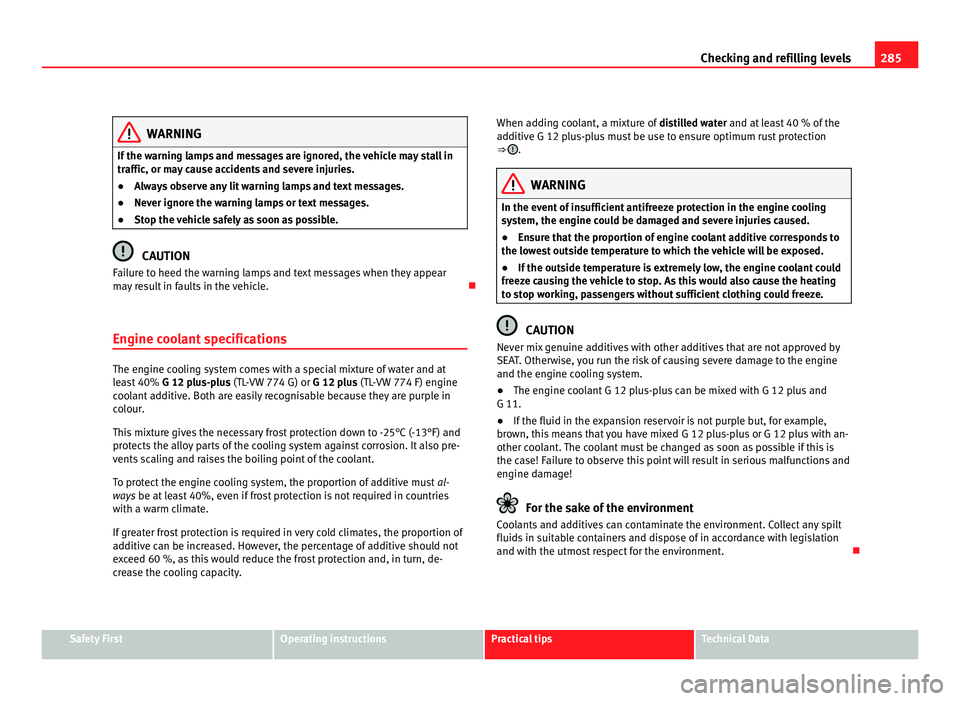
285
Checking and refilling levels WARNING
If the warning lamps and messages are ignored, the vehicle may stall in
traffic, or m a
y cause accidents and severe injuries.
● Always observe any lit warning lamps and text messages.
● Never ignore the warning lamps or text messages.
● Stop the vehicle safely as soon as possible. CAUTION
Failure to heed the warning lamps and text messages when they appear
ma y
result in faults in the vehicle.
Engine coolant specifications The engine cooling system comes with a special mixture of water and at
le
a
st 40% G 12 plus-plus (TL-VW 774 G) or G 12 plus (TL-VW 774 F) engine
coolant additive. Both are easily recognisable because they are purple in
colour.
This mixture gives the necessary frost protection down to -25°C (-13°F) and
protects the alloy parts of the cooling system against corrosion. It also pre-
vents scaling and raises the boiling point of the coolant.
To protect the engine cooling system, the proportion of additive must al-
ways be at least 40%, even if frost protection is not required in countries
with a warm climate.
If greater frost protection is required in very cold climates, the proportion of
additive can be increased. However, the percentage of additive should not
exceed 60 %, as this would reduce the frost protection and, in turn, de-
crease the cooling capacity. When adding coolant, a mixture of
disti
lled water and at least 40 % of the
additive G 12 plus-plus must be use to ensure optimum rust protection
⇒ .
WARNING
In the event of insufficient antifreeze protection in the engine cooling
sys t
em, the engine could be damaged and severe injuries caused.
● Ensure that the proportion of engine coolant additive corresponds to
the lowe
st outside temperature to which the vehicle will be exposed.
● If the outside temperature is extremely low, the engine coolant could
freeze c
ausing the vehicle to stop. As this would also cause the heating
to stop working, passengers without sufficient clothing could freeze. CAUTION
Never mix genuine additives with other additives that are not approved by
SEA T
. Otherwise, you run the risk of causing severe damage to the engine
and the engine cooling system.
● The engine coolant G 12 plus-plus can be mixed with G 12 plus and
G 11.
● If the fluid in the expansion reservoir is not purple but, for example,
brown, thi
s means that you have mixed G 12 plus-plus or G 12 plus with an-
other coolant. The coolant must be changed as soon as possible if this is
the case! Failure to observe this point will result in serious malfunctions and
engine damage! For the sake of the environment
Coolants and additives can contaminate the environment. Collect any spilt
fluids in s
uitable containers and dispose of in accordance with legislation
and with the utmost respect for the environment. Safety First Operating instructions Practical tips Technical Data
Page 352 of 385
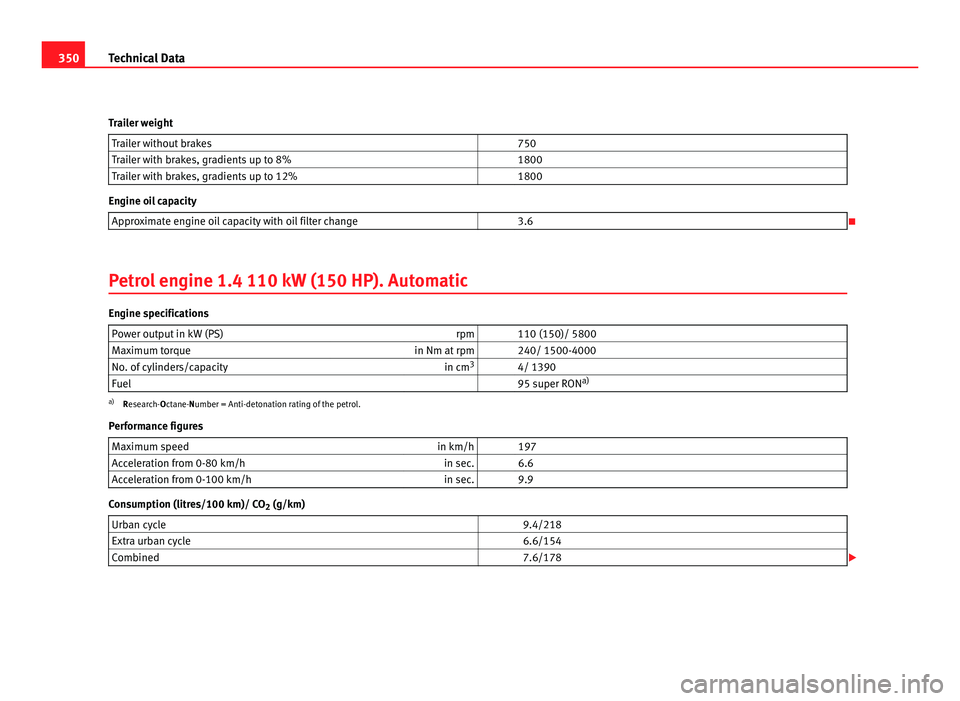
350
Technical Data
Trailer weight Trailer without brakes 750
Trailer with brakes, gradients up to 8% 1800
Trailer with brakes, gradients up to 12% 1800Engine oil capacity
Approximate engine oil capacity with oil filter change 3.6
Petrol engine 1.4 110 kW (150 HP). Automatic Engine specifications
Power output in kW (PS) rpm 110 (150)/ 5800
Maximum torque in Nm at rpm 240/ 1500-4000
No. of cylinders/capacity in cm3
4/ 1390
Fuel 95 super RON a)a)
Research-Octane-Number = Anti-detonation rating of the petrol.
P er
formance figures
Maximum speed in km/h 197
Acceleration from 0-80 km/h in sec. 6.6
Acceleration from 0-100 km/h in sec. 9.9Consumption (litres/100 km)/ CO
2 (g/km)
Urban cycle 9.4/218
Extra urban cycle 6.6/154
Combined 7.6/178
Page 353 of 385
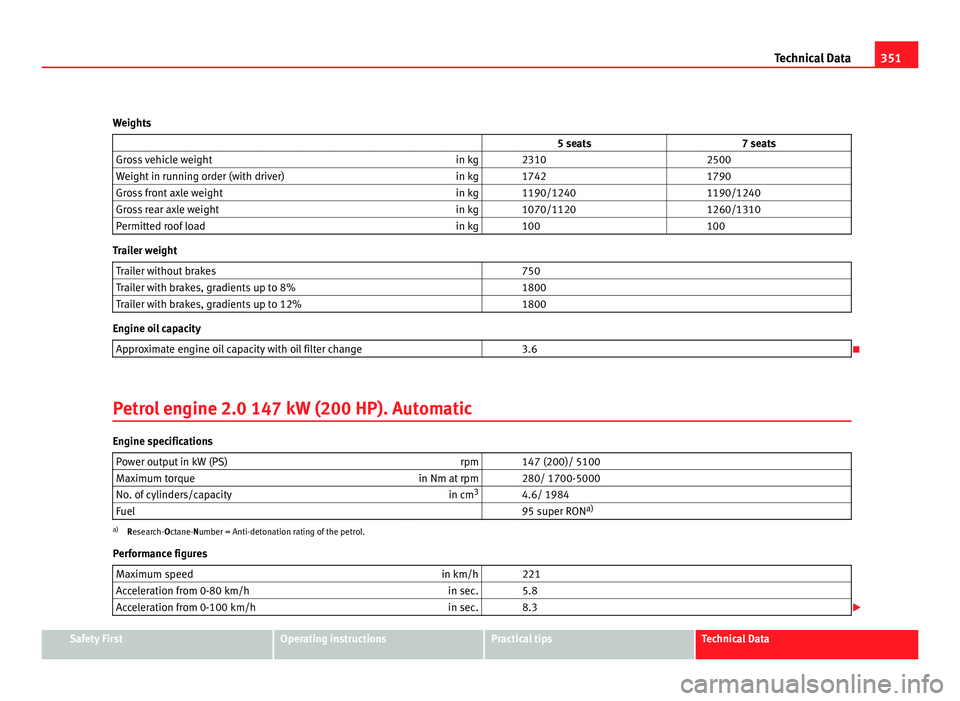
351
Technical Data
Weights 5 seats 7 seats
Gross vehicle weight in kg 2310 2500
Weight in running order (with driver) in kg 1742 1790
Gross front axle weight in kg 1190/1240 1190/1240
Gross rear axle weight in kg 1070/1120 1260/1310
Permitted roof load in kg 100 100Trailer weight
Trailer without brakes 750
Trailer with brakes, gradients up to 8% 1800
Trailer with brakes, gradients up to 12% 1800Engine oil capacity
Approximate engine oil capacity with oil filter change 3.6
Petrol engine 2.0 147 kW (200 HP). Automatic Engine specifications
Power output in kW (PS) rpm 147 (200)/ 5100
Maximum torque in Nm at rpm 280/ 1700-5000
No. of cylinders/capacity in cm3
4.6/ 1984
Fuel 95 super RON a)a)
Research-Octane-Number = Anti-detonation rating of the petrol.
P er
formance figures
Maximum speed in km/h 221
Acceleration from 0-80 km/h in sec. 5.8
Acceleration from 0-100 km/h in sec. 8.3 Safety First Operating instructions Practical tips Technical Data
Page 354 of 385
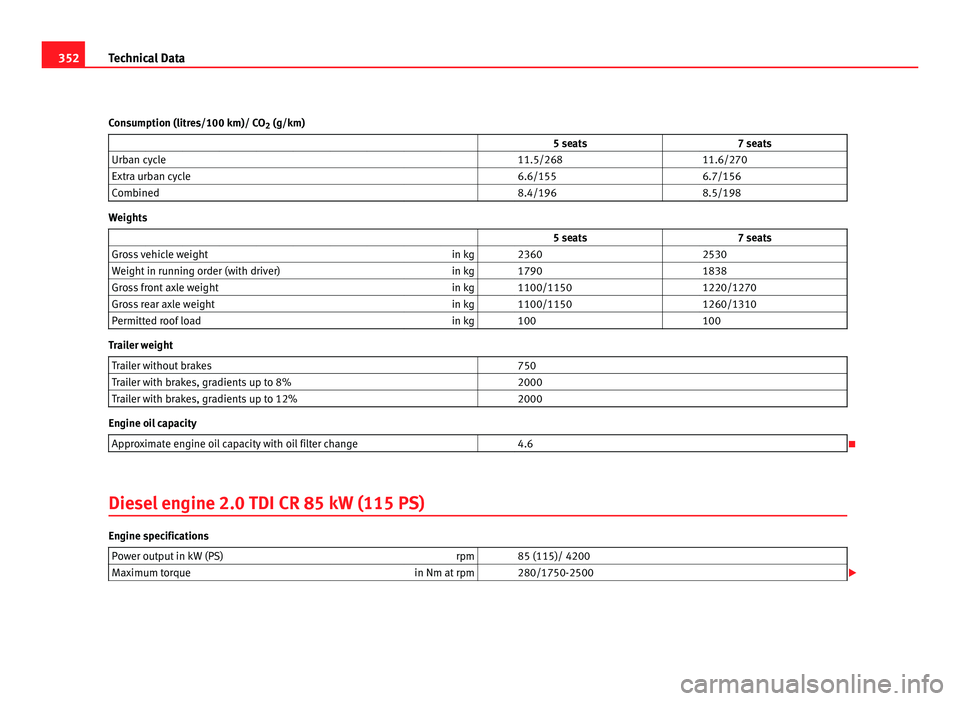
352
Technical Data
Consumption (litres/100 km)/ CO 2 (g/km)
5 seats 7 seats
Urban cycle 11.5/268 11.6/270
Extra urban cycle 6.6/155 6.7/156
Combined 8.4/196 8.5/198Weights
5 seats 7 seats
Gross vehicle weight in kg 2360 2530
Weight in running order (with driver) in kg 1790 1838
Gross front axle weight in kg 1100/1150 1220/1270
Gross rear axle weight in kg 1100/1150 1260/1310
Permitted roof load in kg 100 100Trailer weight
Trailer without brakes 750
Trailer with brakes, gradients up to 8% 2000
Trailer with brakes, gradients up to 12% 2000Engine oil capacity
Approximate engine oil capacity with oil filter change 4.6
Diesel engine 2.0 TDI CR 85 kW (115 PS) Engine specifications
Power output in kW (PS) rpm 85 (115)/ 4200
Maximum torque in Nm at rpm 280/1750-2500
Page 355 of 385
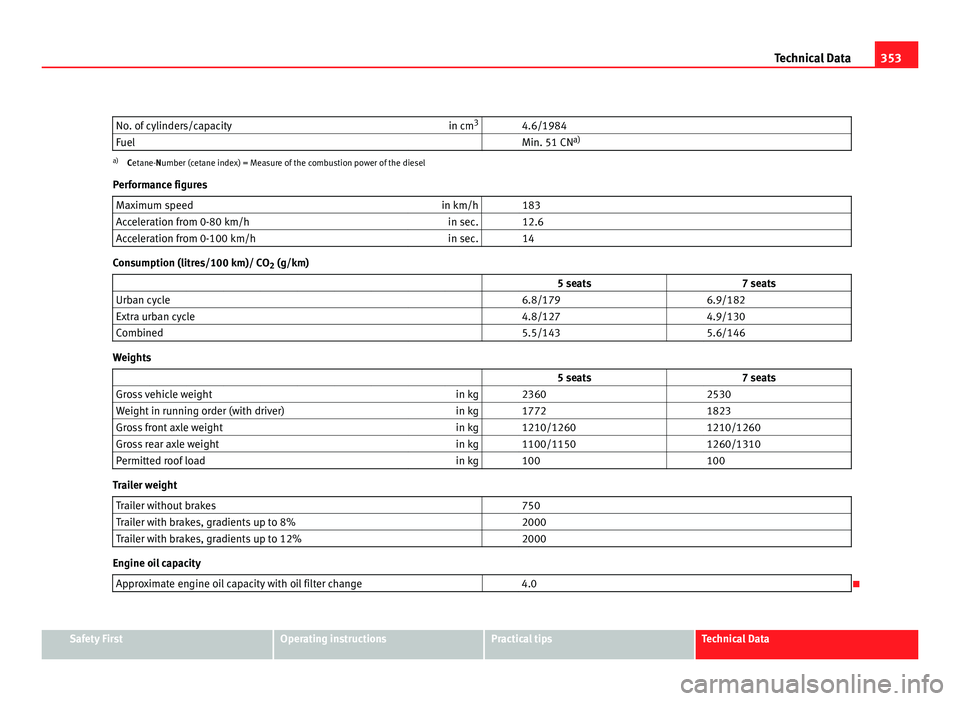
353
Technical Data
No. of cylinders/capacity in cm3
4.6/1984
Fuel Min. 51 CN a)a)
Cetane-Number (cetane index) = Measure of the combustion power of the diesel
P er
formance figures
Maximum speed in km/h 183
Acceleration from 0-80 km/h in sec. 12.6
Acceleration from 0-100 km/h in sec. 14Consumption (litres/100 km)/ CO
2 (g/km)
5 seats 7 seats
Urban cycle 6.8/179 6.9/182
Extra urban cycle 4.8/127 4.9/130
Combined 5.5/143 5.6/146Weights
5 seats 7 seats
Gross vehicle weight in kg 2360 2530
Weight in running order (with driver) in kg 1772 1823
Gross front axle weight in kg 1210/1260 1210/1260
Gross rear axle weight in kg 1100/1150 1260/1310
Permitted roof load in kg 100 100Trailer weight
Trailer without brakes 750
Trailer with brakes, gradients up to 8% 2000
Trailer with brakes, gradients up to 12% 2000Engine oil capacity
Approximate engine oil capacity with oil filter change 4.0
Safety First Operating instructions Practical tips Technical Data
Page 357 of 385
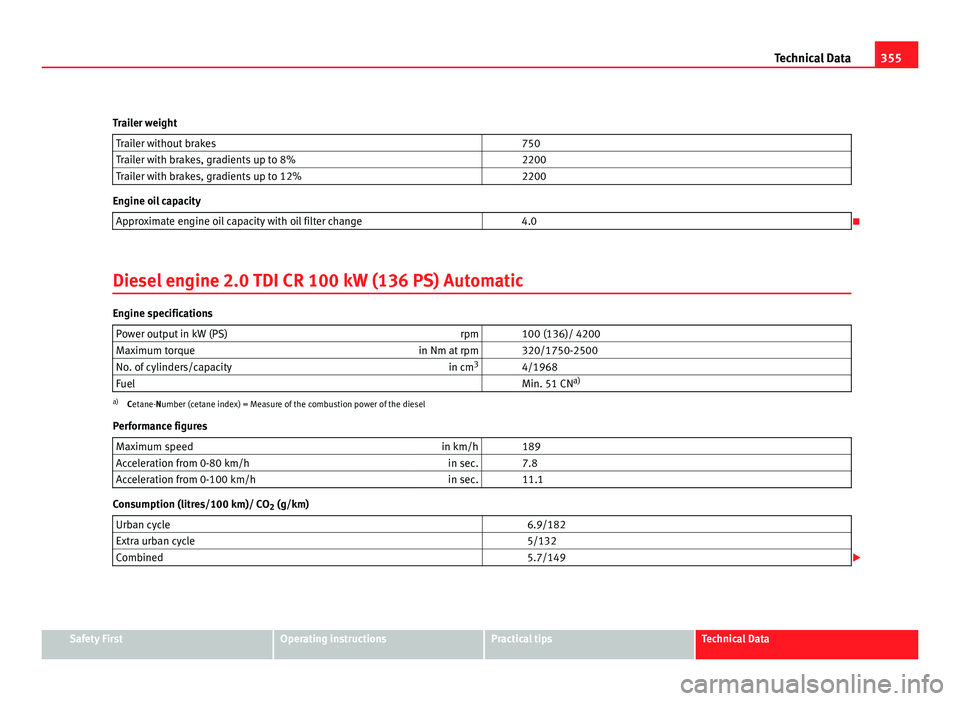
355
Technical Data
Trailer weight Trailer without brakes 750
Trailer with brakes, gradients up to 8% 2200
Trailer with brakes, gradients up to 12% 2200Engine oil capacity
Approximate engine oil capacity with oil filter change 4.0
Diesel engine 2.0 TDI CR 100 kW (136 PS) Automatic Engine specifications
Power output in kW (PS) rpm 100 (136)/ 4200
Maximum torque in Nm at rpm 320/1750-2500
No. of cylinders/capacity in cm3
4/1968
Fuel Min. 51 CN a)a)
Cetane-Number (cetane index) = Measure of the combustion power of the diesel
P er
formance figures
Maximum speed in km/h 189
Acceleration from 0-80 km/h in sec. 7.8
Acceleration from 0-100 km/h in sec. 11.1Consumption (litres/100 km)/ CO
2 (g/km)
Urban cycle 6.9/182
Extra urban cycle 5/132
Combined 5.7/149Safety First Operating instructions Practical tips Technical Data
Page 358 of 385
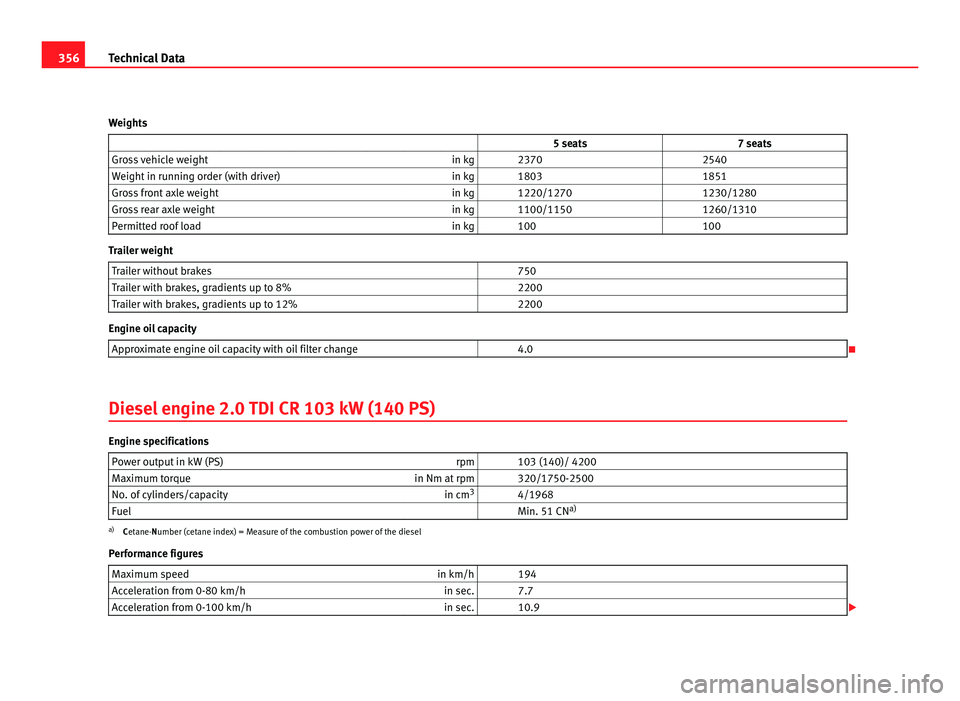
356
Technical Data
Weights 5 seats 7 seats
Gross vehicle weight in kg 2370 2540
Weight in running order (with driver) in kg 1803 1851
Gross front axle weight in kg 1220/1270 1230/1280
Gross rear axle weight in kg 1100/1150 1260/1310
Permitted roof load in kg 100 100Trailer weight
Trailer without brakes 750
Trailer with brakes, gradients up to 8% 2200
Trailer with brakes, gradients up to 12% 2200Engine oil capacity
Approximate engine oil capacity with oil filter change 4.0
Diesel engine 2.0 TDI CR 103 kW (140 PS) Engine specifications
Power output in kW (PS) rpm 103 (140)/ 4200
Maximum torque in Nm at rpm 320/1750-2500
No. of cylinders/capacity in cm3
4/1968
Fuel Min. 51 CN a)a)
Cetane-Number (cetane index) = Measure of the combustion power of the diesel
P er
formance figures
Maximum speed in km/h 194
Acceleration from 0-80 km/h in sec. 7.7
Acceleration from 0-100 km/h in sec. 10.9
Page 359 of 385
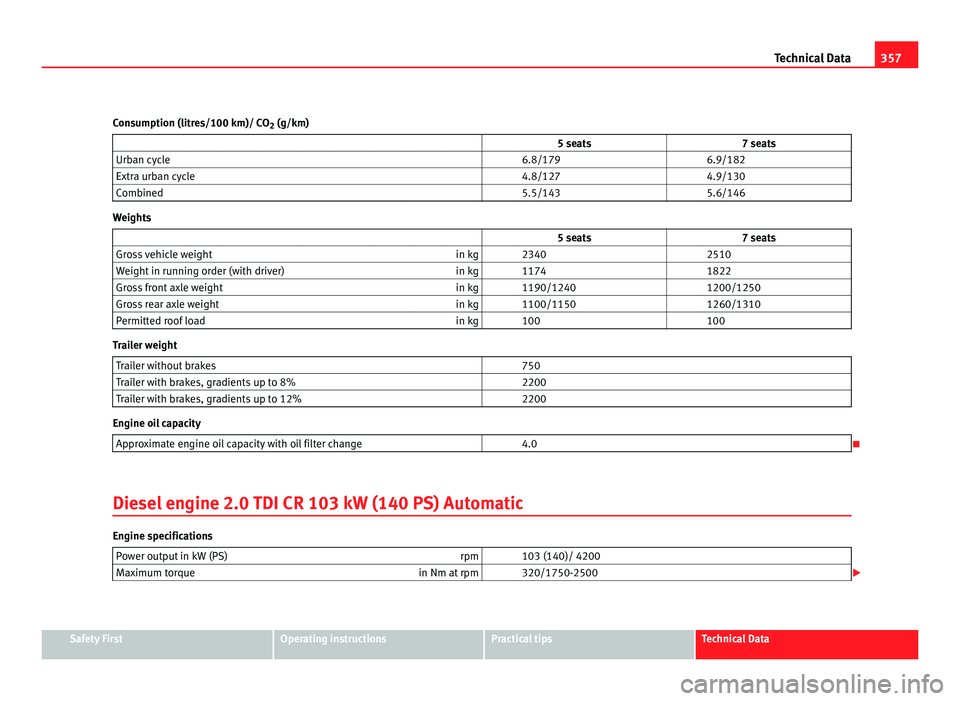
357
Technical Data
Consumption (litres/100 km)/ CO 2 (g/km)
5 seats 7 seats
Urban cycle 6.8/179 6.9/182
Extra urban cycle 4.8/127 4.9/130
Combined 5.5/143 5.6/146Weights
5 seats 7 seats
Gross vehicle weight in kg 2340 2510
Weight in running order (with driver) in kg 1174 1822
Gross front axle weight in kg 1190/1240 1200/1250
Gross rear axle weight in kg 1100/1150 1260/1310
Permitted roof load in kg 100 100Trailer weight
Trailer without brakes 750
Trailer with brakes, gradients up to 8% 2200
Trailer with brakes, gradients up to 12% 2200Engine oil capacity
Approximate engine oil capacity with oil filter change 4.0
Diesel engine 2.0 TDI CR 103 kW (140 PS) Automatic Engine specifications
Power output in kW (PS) rpm 103 (140)/ 4200
Maximum torque in Nm at rpm 320/1750-2500 Safety First Operating instructions Practical tips Technical Data